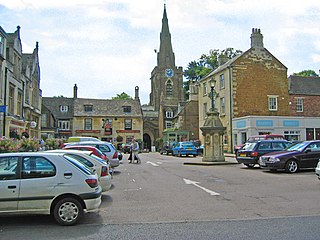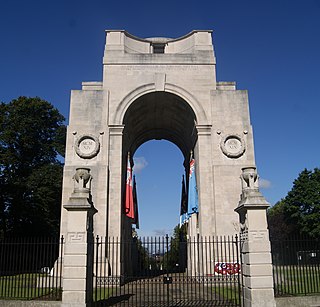
Leicester is a city, unitary authority and the county town of Leicestershire in the East Midlands of England.

Leicestershire is a landlocked county in the English Midlands, being within the East Midlands. The county borders Nottinghamshire to the north, Lincolnshire to the north-east, Rutland to the east, Northamptonshire to the south-east, Warwickshire to the south-west, Staffordshire to the west, and Derbyshire to the north-west. The border with most of Warwickshire is Watling Street, the modern A5 road.

Oakham is the county town of Rutland in the East Midlands of England, 25 miles (40.2 km) east of Leicester, 28 miles (45.1 km) south-east of Nottingham and 23 miles (37.0 km) west of Peterborough. It had a population of 10,922 in the 2011 census, estimated at 11,191 in 2019. Oakham is to the west of Rutland Water, one of Europe's largest man-made lakes, and in the Vale of Catmose. Its height above sea level ranges from 325 ft (99 m) to 400 ft (120 m).

Uppingham is a market town in Rutland, England, off the A47 between Leicester and Peterborough, 6 miles (10 km) south of the county town, Oakham. It had a population of 4,745 according to the 2011 census, estimated at 4,853 in 2019.

The University of Leicester is a public research university based in Leicester, England. The main campus is south of the city centre, adjacent to Victoria Park. The university's predecessor, University College, Leicester, gained university status in 1957.

Aylestone is a suburb of Leicester, England, southwest of the city centre and to the east of the River Soar. It was formerly a separate village, but the growth of the city since the Leicester Extension Act of 1891 incorporated Aylestone into the Borough of Leicester and it is now part of the suburban area.

Great Glen is a village and civil parish in the Harborough district, in Leicestershire, 2 miles south of Oadby. The population of the civil parish at the 2011 census was 3,662. Leicester city centre is about seven miles north west. Its name comes from the original Iron Age settlers who used the Celtic word glennos meaning valley, and comes from the fact that Great Glen lies in part of the valley of the River Sence. The 'great' part is to distinguish the village from Glen Parva.

Leicester General Hospital (LGH) is a National Health Service hospital located in the suburb of Evington, about three miles east of Leicester City Centre, and is a part of University Hospitals of Leicester NHS Trust. It has approximately 430 beds. The hospital is the largest employer in the area.

Leicestershire Fire and Rescue Service is the fire and rescue service which serves the ceremonial counties of Leicestershire and Rutland in England. The service's headquarters are in Birstall, Leicester.

Rutland County Council is a unitary authority responsible for local government in the historic county of Rutland in the East Midlands of England. The current council was created in April 1997. The population of the council's area at the 2011 census was 37,369.

Leicester Town Hall stands in the city centre of Leicester, England, in a square which contains a fountain. The building, which contains a Bike Park, is the main office of the City of Leicester. It is a Grade II* listed building.

The City Rooms is located in the heart of the City of Leicester in England. It has been designated by English Heritage as a Grade I listed building.

Rutland is a landlocked county in the East Midlands of England, bounded to the west and north by Leicestershire, to the northeast by Lincolnshire and the southeast by Northamptonshire.

Welford Road Cemetery is a public cemetery in Leicester, England.

Humberstone and Hamilton is an electoral ward and administrative division of the City of Leicester, England. It comprises the north-eastern Leicester suburbs of Humberstone, Humberstone Garden City, Hamilton and Netherhall.
The following is a timeline of the history of the city of Leicester, England.

The Arch of Remembrance is a First World War memorial designed by Sir Edwin Lutyens and located in Victoria Park, Leicester, in the East Midlands of England. Leicester's industry contributed significantly to the British war effort. A temporary war memorial was erected in 1917, and a committee was formed in 1919 to propose a permanent memorial. The committee resolved to appoint Lutyens as architect and to site the memorial in Victoria Park. Lutyens's first proposal was accepted by the committee but was scaled back and eventually cancelled due to a shortage of funds. The committee then asked Lutyens to design a memorial arch, which he presented to a public meeting in 1923.
Samuel Perkins Pick was an English architect strongly associated with Leicestershire, and co-founder of the architecture and civil engineering firm Pick Everard.

The Towers Hospital was a mental health facility in Humberstone, Leicestershire, England. The administration building, which became known as George Hine House, is a Grade II listed building.

County Hall is a municipal building on Leicester Road in Glenfield, Leicestershire. It is the headquarters of Leicestershire County Council.




















